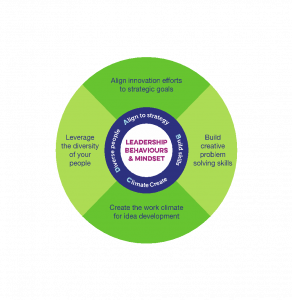How These Three Businesses Improved Their Creativity
Written by Dr Rob Sheffield Thursday 03 January 2019
Creativity is the development of novel and useful ideas, whereas innovation is the outcome of putting these ideas into practice. You cannot have innovation without creativity and therefore, the skill is increasingly important in business.
Top-down, the need for creative thinking is increasingly being sought by teams, organisations, communities and countries. Bottom-up, people want these skills, both for their personal satisfaction and for their long-term employability. And technologically, it is becoming more feasible to ‘match’ creative problem solvers with complex challenges needing imagination.
More than 60 years of research means that we know plenty about how to develop creative ideas. The work of educational scientist Mel Rhodes is particularly renowned. He collected 56 definitions of creativity and grouped them by four themes.
- Creative product: Managers must ask themselves ‘how creative are our work outcomes?’ These may be products, services, processes or business models and should align with organisational strategy.
- Creative process: This looks at how ideas develop through stages, helped by tools, rules and practices. It includes skills training.
- Creative press: Working climate has a huge impact on how much ‘extra’ people choose to put into their work. The biggest factor affecting climate is leadership.
- Creative person: People have different problem-solving styles and these influence the novelty and feasibility of their ideas.
These themes can be used to define a way of working that boosts creativity in organisations. Managers must align innovation efforts to strategic goals; build creative problem solving skills; create the work climate for ideas development and leverage the diversity of their people. Here are three lessons from organisations that have done this.

Three Lessons in Boosting Creativity
1. Even Successful Teams Can Benefit From Skills Training
Liam managed a successful service to support those with drug and alcohol dependency. His team members had introduced several beneficial changes to the service in a short time, but they wanted to expand their work across the county.
The team had not received any formal training in creative thinking. In a workshop they were shown how to adopt a new way of developing ideas. This included redefining challenges; generating many potential solutions; and shortlisting promising ones.
To boost performance, they applied this learning in an inclusive way by working with both internal and external stakeholders to generate ideas (known as the divergent thinking stage); generating many imaginative possibilities; and prioritising the most promising solutions (the convergent thinking stage).
Their subsequent design proposal was successful. They were commissioned to work with new partners, and in a new market – extending their services across their county.
2. Make Time for Creativity
Solverboard is a digital platform set-up in 2015 to help employees to share ideas easily.
Within start-ups, effort from employees is typically very high. People often volunteer to help beyond their often loosely defined roles. But managers wanted to channel that effort into creativity.
Solverboard had a positive climate but our research highlighted that people needed more time to develop and implement their ideas. As a result, senior leaders introduced more clarity to roles and responsibilities and changed expectations around presenteeism. Charlie, a Solverboard founder, told us later what difference the learning had made:
…If there was one takeaway from the training it was: how do we create more space for ideas to thrive? And we have. It’s fundamentally changed how we’re prepared to work. It’s allowed us to admit that busyness doesn’t equal productivity... (And) we’re increasing users and revenue month by month.
3. Creativity Needs Structure as Much as Freethinking
A law firm had advertised internally for a new team to set up an online platform offering legal services. It would be an exciting project that would give the firm a competitive advantage in the industry.
The problem was that the advertisement had attracted five people who were attracted to the open-ended nature of the work, with few rules on how to proceed. The group were strong on generating ideas, but weaker in deciding how to prioritise and implement them. Internally, frustrations were growing because of lack of delivery.
There was limited cognitive diversity in the group.
Dr Michael Kirton’s theory and measure on adaption-innovation proved a useful tool. It explains that those with a more ‘adaptive’ style prefer to use more structure in their problem solving; those with a more ‘innovative’ approach prefer to use less structure. Successful creative teams need both.
The group appointed two new people, both of whom had more interest in bringing structure and process to its work. Its leader also matched work demands to individual styles as much as possible, giving more structured work to people with an adaptive preference, and more exploratory work to those with an innovative preference.
Nine months later, the team were offering legal services online. An employment law package was selling well, the firm’s reputation was enhanced, and it was winning new clients and new revenue.
Leaders and their teams learn quickly how to be more creative. The learning ‘sticks’ when they complement skills training with a supportive work climate, using the diversity they possess, and do all this with innovation clearly aligned to strategy.
Image: Shutterstock
Highlights – 23 April
Time to reduce stress, give motivation a boost and lead sustainably with CMI’s new Sustainability Leadership Qualifications
The value of emotional intelligence in business
How emotional competencies led to greater productivity, job satisfaction and worker retention
Green management is in demand. Do you have the skills to make a difference?
CMI’s Sustainability Leadership Qualifications respond to the need for green management. David Jones shares how they can help
As a manager, what’s the best way to motivate a team?
The CMI community reacts to the question of how to motivate your team during challenging times
Blog
This is a space for people to stay up-to-date with all the latest knowledge, opinions and commentary on management and leadership topics from some industry leaders.
Members See More
CMI Members have access to thousands of online learning and CPD resources. Learn more about our membership benefits
Join The Community
CMI offers a variety of flexible membership solutions, tailored to your needs. Find out more and get involved in the CMI community today.
